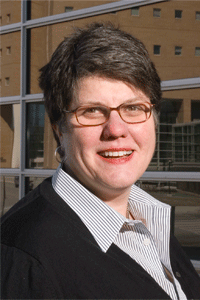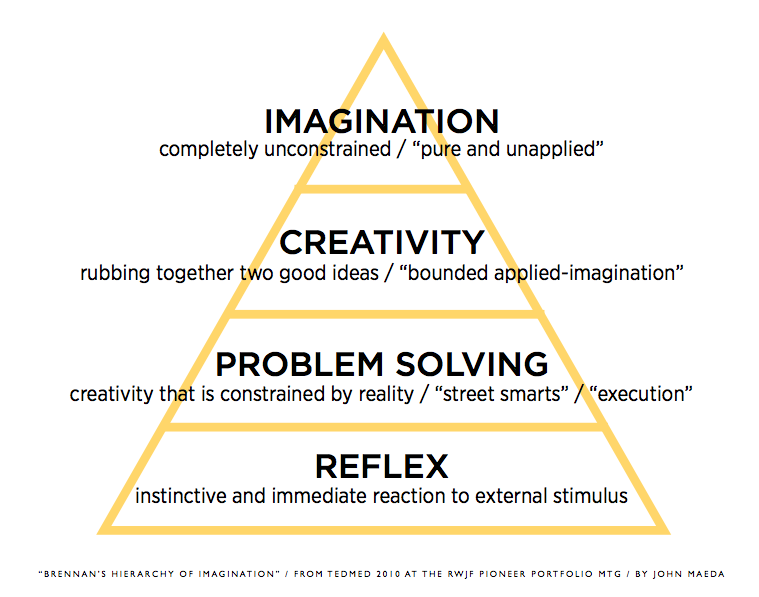I am enough of an artist to draw freely upon my imagination. Imagination is more important than knowledge. Knowledge is limited. Imagination encircles the world.
— Albert Einstein.


Was Einstein born with free-wheeling and vivid imagination? Is imagination a learned and cultivated art, or is it a product of both nature and nurture? What if the ability to imagine had a logical and predictable progression?
Patricia Flatley Brennan, Theme Leader of the Learning Environments Laboratory attended a TEDMED conference in 2010. TEDMED seeks to both inspire and promote ideas on the leading edge of medicine and technology. To open and close the sessions, Jay Walker, curator and chairman of TEDMED, gave short interludes about the brain and imagination. In one of his talks, he mentioned “the ultimate irony that the brain has to imagine how to imagine.”
During one of the breakout sessions, Brennan reunited with John Maeda. At the time, Maeda was President of the Rhode Island School of Design and had been Professor at the MIT Media Lab for 12 years. In 2010, he was featured at the Smithsonian National Portrait Gallery. Brennan and Maeda had experience working together for Project HealthDesign. She was national program director and Maeda was on her advisory committee.
When they met at TEDMED, each of them had been working on how technology could induce health behavior change. Brennan, a skeptic of insight-oriented cognitive approaches, expressed her ideas about imagination to Maeda who was able to formulate them as a drawing. By the end of their session, Brennan’s Hierarchy of Imagination, a construct similar in structure to Maslow’s Hierarchy of Needs, was born.
“Imagination is a gift that can be opened when one has some degree of safety and agency.”
-John Maeda
Like Maslow’s Hierarchy, reflex and innate needs are at the base whereas unconstrained imagination (like self-actualization) which is harder to attain is at the top. The obstacles to creative thought lay in meeting basic needs at the bottom of the pyramid. John Maeda saw imagination as “a gift that can be opened when one has some degree of safety and agency.”
The discussion leading to this concept focused on getting patients to imagine themselves as healthier individuals. Brennan’s hypothesis was that creativity could not necessarily be taught but that it is malleable and could be cultivated – encouraging patients to expand their imaginations could help them envision better outcomes.

In the years since the formulation of Brennan’s Hierarchy of Imagination, Brennan has tested her hypothesis of expanding the capacity for imagination using immersive CAVE technology scenarios in combination with Thompson’s two-factor imagination scale which is a self-report measure developed in 2008 to assess spontaneous imaginal activity. In her pilot study, she has shown positive correlation between a high score on the Thompson test and the number of objects the participant virtually “touched” in a realistic kitchen scenario and a more free-form imagination scenario.
John Maeda has gone on to give a few TED talks himself. He has a popular twitter account (@johnmaeda) focused on technology, design and business. When Maeda periodically tweets Brennan’s Hierarchy of Imagination, he gets an impressive interaction with his followers. The concept continues to resonate with people in the healthcare and design industry.
Looking forward, Brennan is engaging others around the country including a family practice physician, Carlos Jaén, who is based in San Antonio. Together they are formulating a plan on how cities could be built that draw people towards health. They are working to develop an imagination stimulation intervention that is systematic and easy to deliver in primary care clinics
Einstein states Knowledge is limited. Imagination encircles the world. In the world of wellness, Brennan’s Hierarchy of Imagination seeks to close that circle around improved healthcare.


You must be logged in to post a comment.